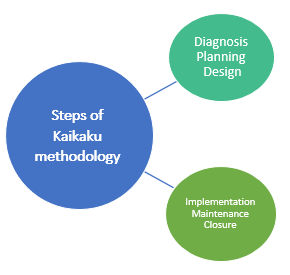Kaikaku is a philosophy more focused on the improvement of production through radical changes in the way of operating, ie reduce implementation time to increase the impact, this methodology as Kaizen has its origin in Toyota.
Kaikaku comes from the Japanese radical change in a very specific and short period of time. It seeks to generate a change of great impact throughout the organizational pyramid, give a new approach to the way of working, the objectives, technology used, this methodology is used when the company enters a valley where there is no improvement and makes use of other methodologies that do not give the expected performance, in many occasions you will find this philosophy as Kaizen Blitz.
The DNA of kaikaku is innovation, because its purpose is to change the way of doing things in a short time, in a transformation rather than technical, human; promoting participation, risks, openness; with the support of teams with vision to propose new things, and open leaders, promoters.
The principles of Kaikaku can be summarized in:
- Strive to amaze your clients, internally and externally, ask yourself Would be the ideal experience of a client? and find ways you can make great contributions to make radical improvements.
- Develop a creative dissatisfaction mentality. Ask yourself: What would an ideal process or workshop look like? And look for opportunities to make radical improvements.
- Look for opportunities to do much more with much less, apply the 80/20 principle to everything.
- See problems as opportunities to do things radically better and polish your winning skills to solve problems.
- Question your assumptions and the status quo. Realize that current practices can entrap people in past ways of seeing things.
- Take different points of view and observe the current practice with a fresh look.
- Learn how to sell your radical ideas to other stakeholders and how to overcome resistance to change.
- With your group bring many creative solutions, think “out of the box”, look for synergy.
- Think positive and act at the moment by starting to improve things and learn along the way.
- Follow the radical improvement action (kaikaku) with small continuous improvements.
Steps of KAIKAKU Methodology

Diagnosis, planning and design:
- A renovation project must be established, through a diagnosis of losses, seeking an improvement in a product or an increase in production. It is understood that it is a substantial improvement.
- It is necessary to define the points and processes to be improved, defining the specific aspects of improvement.
- Present the “creative” work to carry out the improvement actions. This is where the brainstorming of the team members is done.
- Proof of improvement actions: If concrete tools are available, the improvement and its incidence are analyzed before applying it. This in Japan is done with calculation or simulation programs, in Spain it is solved with an Excel sheet where the hypothetical benefits of each improvement are calculated.
Implementation, maintenance and closure:
- Implementation of the improvements and their control tools. We have to make sure that the improvements that are made are effectively achieved. Sometimes, the Excel sheets fail and the improvements are not as substantive.
- Project closure with the valuation of the economic improvements and the actions to maintain the obtained achievements. This is the key of the Kaikaku, the project that is proposed has an end and a project closure.
Be a short or long term strategy, with immediate impact or progressive results over time; The truth is that, beyond equipment and resources, organizations must enrich their processes with philosophies that define a clear horizon of action; a philosophy that transcends the technical and methodological, and permeate institutional and individual actions. There are many ways to achieve this radical leap in practice. Adding an external facilitator or coach to make an initial diagnosis can be a good first step. It is also key to develop a clear definition of how far you want to go with the process, and to achieve alignment of the expectations of the different stakeholders.
Problems when implanting Kaikaku
The difficulties that usually arise when trying to make a radical change in any company, especially are human. The lack of support from management, change the work habits of workers or modify pre-established ideas within the company will be the biggest problem when establishing Kaikaku, becoming (in the best of cases) in small changes of improvement that have nothing to do with the principles and foundations of this system. In order to register these new changes it will be necessary to know how to sell the radical ideas to other interested people and overcome the resistance to change.
